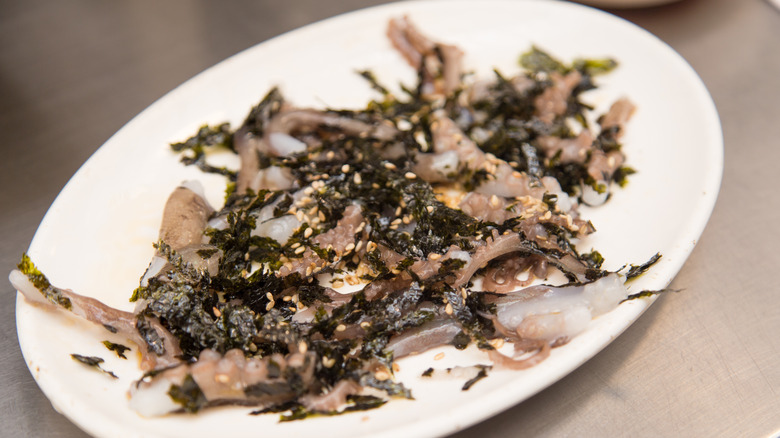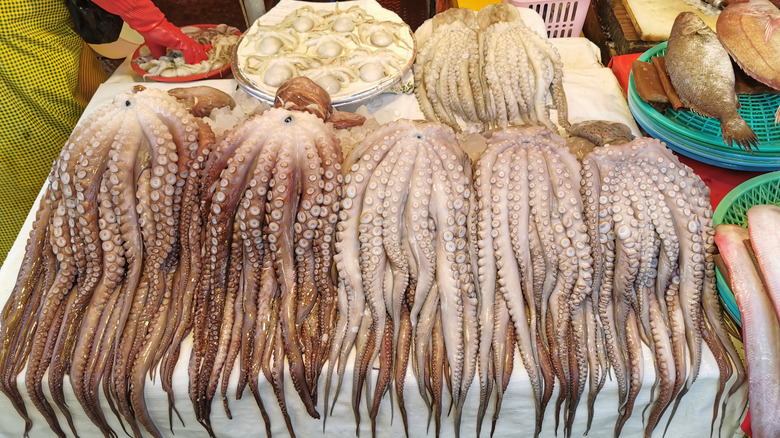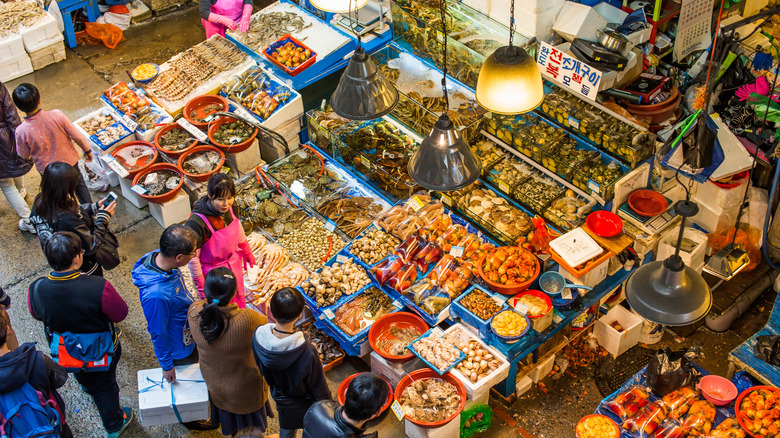Sannakji: The Korean Octopus Dish That's As Fresh As It Can Get
When it comes to raw animal foods, sushi may steal the show, but it's only the tip of the iceberg. Sure, there's also beef-based tartare and lamb carpaccio, but how about octopus?
In Korea, a dish known as sannakji is exactly that — the eight-tentacle invertebrate sliced up fresh from the sea and served to diners swiftly. Unlike the appearance, the taste is not particularly flashy — salty and slightly oceanic to the taste. Texturally, though, is where it gets interesting. In addition to being chewy and a little slimy, the sea creature's tentacles frequently continue to wriggle as they're eaten. Such a characteristic garners intrigue for some diners and generates uneasiness for others — with some animal activists considering the dish cruel.
Regardless, sannakji is not a food simply made for a visceral video clip. Instead, it's a storied Korean dish, eaten since as early as 57 B.C., and thought to regulate blood sugar levels. Accompanied by a chili paste, and some soju, many enjoy it as a frequent addition to their diets. Let's break down what it's all about.
Sannakji ingredients and preparation
Sannakji belongs to an umbrella of Korean dishes known as hwe. Similar to Japanese sashimi, such a term encompasses raw sliced foods, including fish, octopus, and meats. However, in Korea, these foods are accompanied by noodles and vegetables instead of rice.
Sannakji utilizes an octopus variety called nakji. Some incorrectly misconstrue sannakji as a dish prepared with baby octopi when it's actually a smaller species. The chef initiates preparation by squeezing out all of the invertebrate's mucous to eliminate a foul flavor. Next, they chop the legs and head into pieces, which are then quickly served on a plate to the diner. Some establishments top the pieces with sesame oil, ginger, and sesame seeds. While others serve these condiments as a dipping sauce, also mixing including chili paste, vinegar, and sugar. The octopus is rapidly eaten with chopsticks, frequently accompanied by a shot of soju to enliven the experience. Rather than a stand-alone meal, sannakji is consumed as a bite amongst a convivial spread of dining and drinking.
Controversy regarding sannakji
Part of sannakji's spectacle is the wriggling of tentacles as they're consumed. Especially since severed octopus can continue to suction to the back of a diner's throat, the food poses a considerable safety risk. In fact, around six people die every year choking on sannakji — lending the food frequent appearances in the headlines. The best way to mitigate risk is to consume smaller cut pieces and to chew thoroughly before swallowing.
The octopi's continued movement during consumption is also fuel for ethical debate. Unlike humans, octopi have a decentralized nervous system, meaning that decapitation doesn't necessarily mean instant death. As such, some animal rights activists believe eating sannakji is immoral since chewing on the octopus causes it pain. While this is not verifiable, the indeterminate nature does render the dish a non-kosher food. As for other diners, it's a matter of drawing personal ethical boundaries. Sannakji has been engrained in Korean culinary tradition since B.C. times, but it's understandably not for everyone.
Where to find sannakji
In Korea, the dish is widespread throughout the country but is especially popular in Seoul. It's available at both sit-down restaurants and food stalls. Seafood markets in Seoul, including the 24-hour Noryangjin Fish Market, are bustling hot spots for consumption. Alternatively, raw seafood specialty eateries known as Saengson Hoejips or late-night establishments called Simya Sikdangs are great starting points to locate the dish.
Finding it in the U.S. is more difficult, both due to the surrounding controversy and the greater rarity of fresh octopus. However, with the presence of bustling Korean enclaves, sannakji does exist stateside. New York City eatery Sik Gaek serves a plate of the dish, as does Koreatown eatery Hwal Uh Kwang Jang in Los Angeles. Those skeptical of foodborne illness shouldn't fear — octopi are at low risk for infections. Nonetheless, it's still best to leave the preparation of sannakji up to the professionals and never consume it as a solo venture, considering the choking hazards involved.



